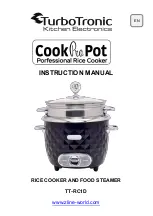
NOTE: SWEEPS BRUSHES MUST BE OF THE TYPE
WITH THE WIRE CENTRES AND GUIDE WHEELS.
In the unlikely event that the appliance is not operating in
freezing conditions, the water must be drained from the
boiler to prevent frost damage.
Failing to maintain your cooker properly can lead to a
chimney fire. Chimney fires occur when combustible
deposits on the inner walls of the chimney ignite. These
combustible deposits on the inner walls of the chimney
ignite. These combustible deposits, called “creosote”, are
a natural by-product of wood burning. A fire hazard exists
if 1/4” of creosote (or more) coats the inner walls of the
chimney.
Failing to maintain your cooker properly can lead to a
chimney fire. Chimney fires occur when combustible
deposits on the inner walls of the chimney ignite. These
combustible deposits on the inner walls of the chimney
ignite. These combustible deposits, called “creosote”, are
a natural by-product of wood burning. A fire hazard exists
if 1/4” of creosote (or more) coats the inner walls of the
chimney.
Prevention
Chimney fires do not occur in clean, intact, properly
installed chimneys. Have a professional chimney sweep
clean and inspect your appliance at least once a year.
More frequent cleanings may be required, based on the
type of fuel burned, the type of appliance, and the
frequency of use. In general, an older appliance or one
that is used frequently, will require more than one clean
per year.
Prevention
Chimney fires do not occur in clean, intact, properly
installed chimneys. Have a professional chimney sweep
clean and inspect your appliance at least once a year.
More frequent cleanings may be required, based on the
type of fuel burned, the type of appliance, and the
frequency of use. In general, an older appliance or one
that is used frequently, will require more than one clean
per year.
Detection
The first indication of a chimney fire is usually the noise -
a roaring sound that grows louder as the fire’s intensity
increases. Clouds of black smoke and sparks will be seen
exiting the top of the chimney; in severe fires, flames can
several feet about the chimney.
Action
In case of a chimney fire follow these steps but do not put
yourself or others in peril.
1. Call the fire brigade immediately.
2. Get everyone out of the property.
3. Close down the air supply to the appliance i.e. the
primary air spinner and the flue damper. Limiting the
fire’s air supply will reduce its intensity. If there is a
damper in the chimney connector, plug or close the
opening.
4. If a fire extinguisher is available, open the appliance
door just enough to insert the nozzle of a 4 kg dry
chemical fire extinguisher rated for Class ABC fires.
Discharge the entire content of the extinguisher into
the appliance and shut the door.
5. If possible, wet down the roof and other outside
combustibles to prevent fires ignited by shooting
sparks and flames.
6. Closely monitor all combustible surfaces near the
chimney. During severe chimney fires, these surfaces
can become hot enough to ignite.
After a chimney fire, have the chimney inspected by a
professional sweep or cooker installer.
8
Fig. 12
Fig. 13
Fig. 14
CHIMNEYS







































